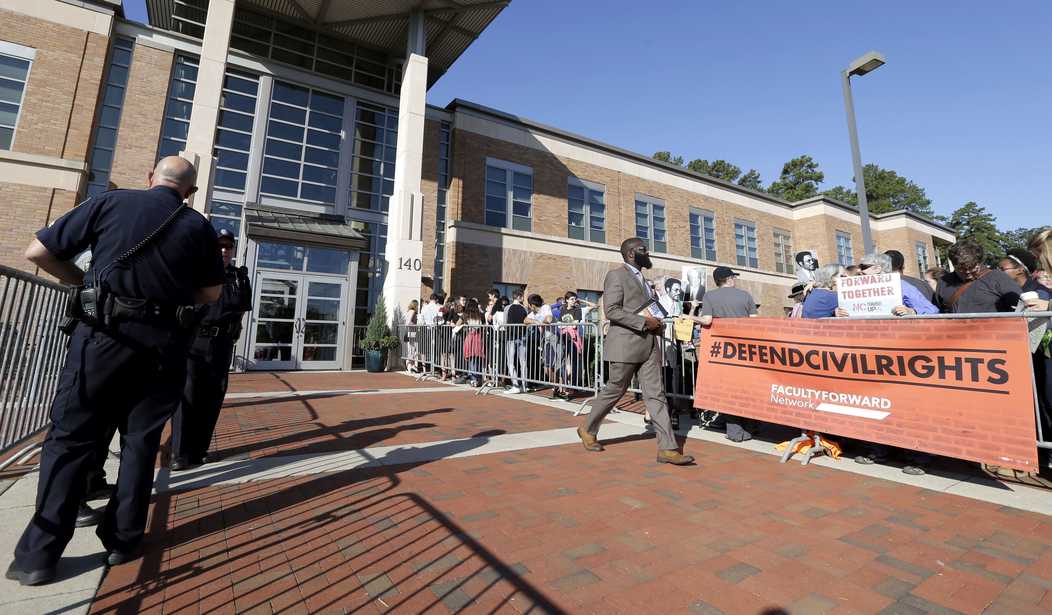Everyone is familiar with the Supreme Court decision in Brown v. Board of Education which put an end to racial segregation in schools, leading to a period of civil unrest. The court determined that “separate but equal” was an unacceptable and likely unobtainable standard, and that all students must receive the same opportunities regardless of race. This eventually led to rural arguments over bussing, “white flight” and other social conflicts. But then it all sort of faded away and people went back to sending their children to schools in their community with no applicants being denied a seat based on race. Problem solved, right?
It was for a while, but now things have started to change yet again. As Andrew Kerr explains at the Free Beacon, school boards are embracing a new model of operation where separate but equal is back, except it comes with an asterisk. It’s okay to split up classes based on race, but only if the excluded students are white. Classes composed entirely of one minority or another are fine because these “affinity classes” prevent some minority students from experiencing “anxiety” caused by learning alongside peers of another race. He points to a program in Evanston, Illinois as an example.
Separate is “inherently unequal,” the Supreme Court declared nearly 70 years ago. Today, journalists and educators are working overtime to tell us that Brown v. Board of Education was written with an asterisk.
A Wall Street Journal report on Sunday celebrated an Evanston, Illinois, program through which students can opt-in to racially segregated “affinity classes.” Black-only English? Check. There’s even an AP calculus class for Latino students who, according to Evanston superintendent Marcus Campbell, might feel “anxious” learning integrals alongside their black peers.
This perverse approach to education isn’t illegal, according to the Journal. No, the paper framed this sort of discrimination as a bold, constitutionally kosher effort to boost the performance of minority students.
The underlying argument is that because these “affinity classes” are optional, they pass constitutional muster. Constitutional law experts disagree and the linked report quotes a few of them. The Title VI law that bans race discrimination by federally funded programs “does not distinguish between mandatory and optional activities.” Segregated courses of any sort are “blatantly unconstitutional.”
In addition to that district in Illinois, racially segregated classes are now available in Minneapolis, Seattle, San Francisco, and Oakland. Apparently, people are not yet challenging them in court because it seems impossible that they would be allowed to stand. However, one of the teachers defending this approach complained that sometimes, “Black students are expected to conform to a white standard.” This is a math teacher we’re talking about. How are there different standards based on race when you’re learning math?
This is part of the larger problem that we’ve seen engulfing so many schools. A lot of this is cooked up in the teachers’ unions and it’s coming entirely from the left. The true “asterisk” in this theory of education is that racial discrimination in education is always bad (which is true) unless it’s in the form of discrimination against white students. This may be an alternative to the other approach we’re seeing where if some segment of minority students are failing to meet the standards, the standards are simply lowered until everyone meets them or they are simply eliminated and “everyone gets a trophy.”
It’s simply shocking how a group of supposed academics just got together, cooked up an idea like this and announced it was starting. In Evanston, they set up one math class that was solely for students who “identified as Black” and another for students who “identified as Latinx.” (There’s that stupid word again.) It was apparently not only too potentially anxiety-inducing for Latino students to sit in the same class with white students, but they were assumed to be unable to handle being in the room with Black classmates as well. And somehow everyone seemed to be okay with that.
Back when I was growing up there were still public debates expressing the fear of possible race wars in the country caused by forced bussing. I really thought those days were well and truly behind us. But today, it increasingly seems as if race wars might be growing in popularity. However, they aren’t being started by white people this time.








